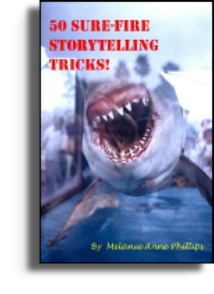|
For Story Structure |
|
For Story Development |
|
|

|
|
Introduction
Over the last twenty-
Table Of Contents
Trick 1 -
Trick 2 -
Trick 3 -
Trick 4 -
Trick 5 -
Trick 6 Non-
Trick 7 -
Trick 8 -
Trick 9 -
Trick 10 -
Trick 11 -
Trick 12 -
Trick 13 -
Trick 15 -
Trick 16 -
Trick 17 -
Trick 18 -
Trick 19 -
Trick 20 -
Trick 21 -
Storytelling Tricks For Novelists
Trick 22 -
Trick 23 -
Trick 24 -
Trick 25 -
Storytelling Tricks For Screenwriters
Trick 27 -
Trick 28 -
Trick 29 -
Trick 30 -
Trick 31 -
Trick 32 -
Trick 33 -
Trick 34 -
Trick 35 -
Trick 36 -
Trick 37 -
Trick 38 -
Trick 39 -
Trick 40 -
Trick 41 -
Storytelling Tricks for Multi-
Trick 42 -
Trick 43 -
Trick 44 -
Trick 45 -
A Grab Bag of Tricks for All Media
Trick 46 -
Trick 47 -
Trick 49 -

|
50 Sure- |